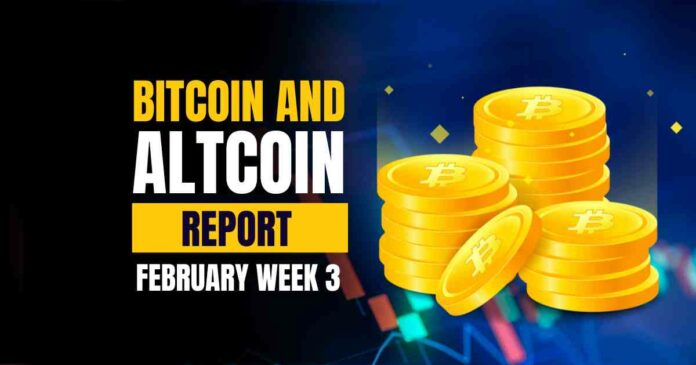Bitcoin had a solid start to the year despite its second-worst annual performance in 2022, when it dropped 64%. As bullish sentiment overcame worries about a growing US crypto enforcement effort and the background of rising interest rates,
Bitcoin ended the work week on an even equilibrium, recovering from earlier steep losses to finish stagnant. What is happening in the market?
The Macro Picture
Before we look into the state of Bitcoin this week, let’s analyze the macro narrative. The bearish macro variables, such as the CPI and PPI coming in higher than anticipated, appear to be ignored by the crypto markets. The correlation between cryptocurrencies and the stock market has weakened recently. It indicates that although the crypto factors are in charge, they are also bearish.
The strange inflows from institutional investors, primarily through USDC, are the only thing keeping the crypto market afloat now. The roster of buyers includes Justin Sun, the founder of Tron.
Source: Lookonchain
Are institutional investors trying to create some exit liquidity with the bit of retail speculation left in the crypto market? Over the past year, a lot of volatility has been sucked out. So, money is still moving around the market and pursuing yields in different spots. And many are currently hesitant to engage in new investment possibilities, particularly those involving risky assets like cryptocurrency.
Given that the crypto market is undergoing what some crypto policy experts call a “carpet bombing,” institutional buyers attracting last-minute exit liquidity makes sense. A terrifying aspect is that this regulation crackdown has only affected the United States so far. It has sparked speculation that other countries, mainly the UK, will follow suit. Additionally, Unaccountable international bodies are posting their proposals for a crackdown.
Crypto And The Looming Regulatory Hammer
Regulators invaded the crypto market in the first few weeks of February with the alleged objective of cleaning it up for investors. But instead of cooperating with American companies to help establish consumer protections while remaining competitive with foreign alternatives, they are shutting down services and fining them.
Any asset that the SEC deems to be a security must register with the body to avoid paying hefty penalties and, of course, having its listing removed from all exchanges. It’s one thing if an altcoin like XRP is delisted, but doing that to a stablecoin like USDC has unimaginable consequences.
I have read "PwC: Global Crypto Regulation Report 2023".
I can predict which of the TOP-25 most developed countries in the world will be the first to fully legalize the cryptocurrency market: 1. Switzerland and Japan (estimated 2024) 2. USA, Great Britain and Germany (est. 2025) pic.twitter.com/YoiHMDJcWW
— Oleg Mykolajovych 🇺🇦🤝🇪🇺🇬🇧🇺🇲 (@BTC_Forex_ATH) February 19, 2023
Gary Gensler, the head of the SEC, has stated that some stablecoins are securities, although there is no prospect of financial gain from holding these stable assets. Or is there?
What Does It Mean For Stable Coin?
You may be aware that Do Kwon, a Terra co-founder, is now the target of legal action by the SEC. So, the SEC claims that Terra’s numerous assets, including the UST “stablecoin,” are securities.
Why? The short explanation is that Do Kwon gave UST the impression that it would make money by developing an ecosystem of dApps for it, including the now-infamous Anchor Protocol, which promised high yields. Many fear the SEC will apply the same arguments to other stablecoins.
It ties into the pending SEC case against Paxos. The company has been given a Wells Notice by the SEC, which provides it with 30 days to explain why SEC shouldn’t prosecute it. On a side note, the SEC has sued in 80% of situations where it has issued a Wells Notice, regardless of the answer. The SEC asserts that BUSD is an asset, just like with Do Kwon, and it may have something to do with the BUSD wrapped on BSC.
My stablecoins guide – in case you missed it. 👇
Seems relevant today as #BUSD was labeled a security. #USDC & #USDT future remains uncertain.
I suspect USDC won't get any heat as it's a #Blackrock / #Fidelity pet. US has all reasons to defend it & crush competitors. pic.twitter.com/DezgWuPSes
— Duo Nine ⚡ discord.gg/ycc (@DU09BTC) February 13, 2023
This scenario leads to the third rationale the SEC might use to defend a stablecoin crackdown. Stablecoins are securities by extension because they are backed by securities (US government debt), even though there is no expectation of profit. In addition, there are expectations that a stablecoin will maintain its peg despite its erratic backing due to the efforts of a third party, particularly stablecoin issuers.
The harsh truth is that despite not being rational, the argument is logical. That’s sufficient for the SEC and the lawmakers who have been pressuring the regulator to crack down on the crypto market.
Let’s move on to on-chain data analysis.
Investor Confidence Is Booming.
Open interest (OI) in Bitcoin perpetual future markets shows that traders have been accumulating long holdings so far this year, as both OI and price have increased.
The same is true for ETH perpetual futures markets, though there has been some indication of profit-taking by traders as values have increased past $1,650. But in general, things continue to be the same.
In reality, funding rates have been largely positive this year, indicating that traders are willing to go long on bitcoin. Since favorable funding rates are anticipated to continue into 2023, Ethereum traders are also in a bullish mental state.
But it’s essential to remember that orders from sellers have once more exceeded orders from buyers, i.e., the taker buy/sell ratio is below 1.
The taker buy/sell ratio for ETH has once again fallen below 1, reaching an all-time low of 0.89 at the end of January. It has fallen to this level for the first time since January 2023.
Meanwhile, there is evidence that the market for bitcoin in the United States is rising. The fact that Coinbase‘s premium has surged to its highest level since June 2022 serves as evidence for this. The ETH Coinbase premium, which has already risen to 7%, has also significantly increased over this year. The price premium seen lately is the highest since August 2022.
Almost 82% Of UTXOs Are In Profit.
The % of UTXOs that are profitable has surpassed 80% for the first time in the previous ten months. BTC’s price was $43,000 to $45,000 the last time we were in this area.
It indicates that many new UTXOs were created in the $19,000 to $20,000 range, where buyers amassed more Bitcoin. Let’s look at what Realized Price-UTXO Age Bands has to say.
Realized Price-UTXO Age Bands displays realized prices arranged by age. In the graph below, the average of the assumed price for coins between three and six months old can be visualized as similar to a moving average but on-chain adjusted.
It’s clear that in the two cycles before this one, when the bear market had already begun to affect the markets, price movements above this band had resulted in significant uptrends.
There is a chance that BTC established a bottom in November, even if the price falls below the indicated band (as it did in 2019). However, the confluence between perspectives is crucial since no alternative viewpoints are considered for this conclusion.
Is There Still Space For Bullish Momentum For BTC?
The Williams%R momentum is a momentum indicator that helps you see the current trend’s direction. Readings between 0 and -20 are regarded as overbought, while a reading of -80 to -100 as oversold. The indicator mirrors the level of the close relative to the highest high for the look-back period.
The Williams % R (60-day period) for BTC: Estimated Leverage Ratio indicates that it is possible that the leverage level still leaves Bitcoin with room for further bullish momentum to $27100. It is because there was a gap in on-chain trading volume before this resistance, which means no significant traded volume could have put considerable pressure on Bitcoin.
Is It Too Early To Declare A Bull Market?
All market participants have recently suffered significant losses due to the crypto bear market. Even long-term investors, typically in profits, are now suffering losses.
So, long-term holders frequently behave in this manner in the final stages of a bear market when everyone in the market panic sells or “capitulates.”
The SOPR indicator for a long-term holder calculates their profit or loss. This metric has been trending below one since late May 2022, showing that long-term holders are continuously enduring a loss.
In the past, the indicator passing above one coincided with the bull market’s start. Due to the recent upward trend in the price of Bitcoin, the metric began to recover and increased slightly.
However, it is still too soon to declare that the $15.5K level marks the bottom of the bear market, as the most recent impulsive recovery may only be a bull trap. To predict the direction of the price, it is critical to monitor the SOPR metric for long-term holders carefully.
Market Manipulation And BTC Mirroring 2017
Suspicions regarding the intentions of high-volume Bitcoin exchange traders coincide with a fresh surge higher into the weekly end for the BTC price.
According to TradingView data, BTC/USD reached $25,038 on Bitstamp. Bulls continued to press for a support-resistance flip of the vital level during after-hours trading, which would have signaled the beginning of a significant resistance cloud made up of several long-term trend lines.
The sentiment among traders was tense as the weekly close approached. So, material indicators cautioned that large-volume players were still manipulating spot price by shifting bid and ask levels after analyzing Binance order book activity.
Source: Material Indicators
In the meantime, the longer-term perspective gave the trading suite Decentrader. The company claimed that everything was proceeding in accordance with historical norms by comparing current market behavior to Bitcoin’s previous four-year halving cycle.
The platform claimed the recent move from $17k to $23k matches the 2017 move around the 1000-day point.
Source: Decentrader
Hash Rate And Difficulty To Reach New Records?
As the month ends, Bitcoin’s network fundamentals maintain the bullish sentiment firmly. The subsequent automated readjustment will see the difficulty in adding an expected 10% to its current total. This scenario will raise the difficulty to new all-time highs, canceling the prior readjustment’s slight decline.
Source: BTC.com
It is a critical metric for assessing the sentiment of Bitcoin miners because such significant increases imply corresponding improvements in competition for block subsidies. It follows growing attention to so-called “ordinals” fees, with miner profitability rebounding after being under pressure for months.
Source: Glassnode
Data from the on-chain analytics, Glassnode, backs this. On rolling monthly timeframes, miners have started holding more Bitcoin than they sell, reversing a pattern of net sales that had been in place since mid-January. The hash rate of the Bitcoin network is still over 300 exahashes per second (EH/s), according to raw data from MiningPoolStats.
Source: MiningPoolStats
⬆️ For more cryptocurrency news, check out the Altcoin Buzz YouTube channel.
⬆️ Our popular Altcoin Buzz Access group generates tons of alpha for our subscribers. And for a limited time, it’s Free. Click the link and join the conversation today.




























